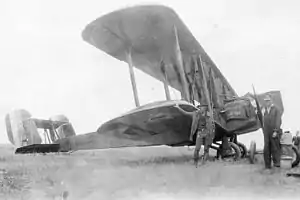Curtiss XNBS-4
The Curtiss Model 36 XNBS-4 was a 1920s prototype biplane night bomber built by the Curtiss Aeroplane and Motor Company for the United States Army Air Corps.[1]
| Curtiss XNBS-4 | |
|---|---|
 | |
| Role | Biplane night bomber |
| National origin | United States |
| Manufacturer | Curtiss Aeroplane and Motor Company |
| First flight | 1924 |
| Primary user | United States Army Air Corps |
| Number built | 2 |
| Developed from | Martin NBS-1 |
Development
The XNBS-4 was developed by Curtiss as an improvement on the Martin NBS-1. Two prototypes, AS68571 and AS68572, were built. The design did not enter production because it offered no significant improvement over the NBS-1.[1]
Specifications
Data from National Museum of the United States Air Force[1] and Aerofiles[2]
General characteristics
- Crew: 4
- Length: 46 ft 6 in (14.17 m)
- Wingspan: 90 ft 2 in (27.48 m)
- Height: 15 ft 9 in (4.80 m)
- Airfoil: Curtiss C-72[3]
- Gross weight: 13,795 lb (6,257 kg)
- Powerplant: 2 × Liberty L-12A V-12 water-cooled piston engines, 435 hp (324 kW) each
Performance
- Maximum speed: 100 mph (160 km/h, 87 kn) at sea level
- Cruise speed: 95 mph (153 km/h, 83 kn)
- Stall speed: 53 mph (85 km/h, 46 kn)
- Range: 620 mi (1,000 km, 540 nmi)
- Service ceiling: 13,000 ft (4,000 m)
Armament
- Guns: 5x 0.3 in (7.62 mm) machine-guns
- Bombs: 1,907 lb (865.0 kg)
References
Wikimedia Commons has media related to Curtiss XNBS-4.
- "Factsheet: Curtiss XNBS-4". NMUSAF. Archived from the original on 16 June 2012. Retrieved 12 July 2017.
{{cite web}}: CS1 maint: bot: original URL status unknown (link) - Eckland, K.O. "K through Z". aerofiles.com. Retrieved 31 March 2015.
- Lednicer, David. "The Incomplete Guide to Airfoil Usage". m-selig.ae.illinois.edu. Retrieved 16 April 2019.
This article is issued from Wikipedia. The text is licensed under Creative Commons - Attribution - Sharealike. Additional terms may apply for the media files.